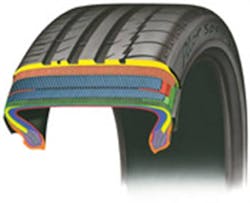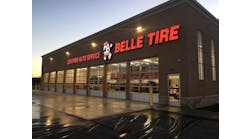Run-flat tires have been around for years, fitted to special -- read “expensive” -- automobiles. But are tire dealers and the mass market embracing run-flat tires?
Not exactly, according to Goodyear Tire & Rubber Co.’s Bill Hopkins, vice president-advanced concepts. “More attention and care is needed to convince the consumer as well as the dealer about them, and tire manufacturers that offer run-flat tires continue to educate their dealers about new fitments and what is coming.
“Overall, it’s important to acknowledge that the integration of run-flats takes time. In fact, the full-scale acceptance of any new technology is not an overnight process. Think of ABS, electronic stability control, even the transition of bias to radial tires.
“It also is important to note that while some claim the industry and consumer acceptance of run-flat tires has been less than expected, the run-flat tire has actually become an integral part of the lives of many,” says Hopkins. “There have been many consumers who have embraced run-flats, have been driving on them every day, and have experienced the benefits they provide.”
[PAGEBREAK]
Two technologies
The basic run-flat tire technology has evolved into two different approaches to allow a tire to run with zero air pressure and still support the vehicle in a safe manner for 100 to 150 miles at 50 mph. These technologies are SST (self-supporting tires) and Groupe Michelin’s PAX system design.
SSTs are built with heavily reinforced sidewalls that are able to support the vehicle and offer fair, but reduced, performance parameters when the tire is void of air pressure. This is the most common approach for run-flat tires and offers the lowest cost because the wheels do not need to be modified to use it. (BMW AG has chosen to use an extended hump rim for all their run-flat applications.)
The Michelin PAX system technology (such as on the Honda Odyssey) in some ways is similar to the tire-in-a-tire liners NASCAR developed with Goodyear to keep a tire supported if it blows out in a race at 200 mph.
The Michelin system utilizes a support ring attached to a special inner tire rim. In the case of the PAX system, the sidewall of the tire doesn’t have to be as stiff as an SST, so performance and ride comfort are improved for it. But it does take a unique wheel rim to allow mounting the support ring, and the design of the area where the tire and rim meet at the bead also is unique.
The benefits of both systems are significant. At least they sound significant discussed alone, without cost and repairability considered:
* Less vehicle weight (no spare) equals better fuel mileage, which is important to the original equipment manufacturer as well as the consumer.
* More stability when air is lost. The driver does not have to deal with a vehicle losing its inherent dynamics, like what happens in a flat tire situation, which instills driver confidence.
* Not having to stop and change the tire on the highway. This is probably seen as the greatest benefit, since most consumers simply do not want to get their hands dirty, lack the knowledge to change a tire safely or do not want to wait for AAA or another roadside service provider.
From the OE side, the major applications are Corvette and BMW, plus selected models of Cadillac and Lexus. BMW makes them available on different models of their BMW 3, 5, 6 and 7 Series models. The company reports it “remains committed to the run-flat strategy in the U.S.”
And all Chevrolet Corvettes are equipped with them. (Since space is at a premium on Corvettes, eliminating the spare is looked at as a very smart packaging choice.)
[PAGEBREAK]
On the down-side, along with cost, run-flats have the reputation of offering a harsher ride. Most of the more recognized automotive magazines, when testing vehicles with run-flat tires, put a caveat in their copy saying something like: “Not bad for being equipped with run-flat tires.”
Since all run-flat tires to date have been for high performance vehicles, they are all expected to be hard riding (they are) and expensive (they are). And buyers of expensive and exclusive vehicles are somewhat used to paying the price for being part of the exclusive club their choice of marquee and model brings to the party.
But the benefits may not be enough. Michelin reports, “The extended mobility or ‘run-flat’ segment has not developed as quickly as expected and currently accounts for less than 3% of the OE tire market. Additionally, no industry standard for extended mobility has emerged, since carmakers sometimes have different expectations of system performance. Therefore, Michelin will not pro-actively pursue additional fitments for its PAX system solution.”
The company continues to provide broad after-sales service for existing PAX systems on the road and to produce OE tires for existing contracts. “Michelin also will continue to produce and develop the zero pressure self-supporting tire, primarily in response to requests from vehicle manufacturers.”
From the OE tire side
We turned to top industry experts for an insider’s look at run-flat tires.
Doug Girvin, director of product marketing, answered our questions for Michelin North America Inc.; Charles van Heusden, manager training and product development, answered for Kumho Tire U.S.A. Inc.; and Hopkins responded for Goodyear. Other OE tire manufacturer representatives and industry experts participated anonymously.
MTD: What do you see as the reasons run-flat tires haven’t become an integral part of our lives to date?
Van Heusden: The run-flat product is costly to replace and can only be used once, since after the initial puncture the run-flat tire is no longer run-flat-capable, even if refilled with air after less than their 150- mile capability.
Hopkins: Initially, cost may have been a factor, but much of that was due to a need to have a warning system installed on the vehicle to indicate a tire had lost air. Now that all new vehicles are required to be equipped with TPMS, cost should no longer be a major factor. Another clarification here is that most run-flat tires are also UHP (ultra-high performance) tires, so they are priced higher than average anyway. And, as is typical of emerging technologies (such as run-flat tires), as volume increases, costs tend to move inversely throughout the supply chain.
[PAGEBREAK]
Industry insider: Cost is a relative thing, and although run-flat tires are more expensive, their benefits do justify them. But, it will take large-scale fitments at the OE level to make them cost effective on small sedans and light SUVs. When that happens, the costs will be in the right neighborhood for the average consumer.
MTD: Has there been any new technology in the last two to three years that will allow them to gain more acceptance?
Girvin: Run-flat technology has been steadily improving over the past few years, to deliver the best compromise of mass and performance.
Van Heusden: More heat-resistant polymers have been developed and are being used in newer run-flat products. This allows for a reduction in sidewall supporting material and results in lighter weight and a better ride.
Hopkins: Some consumers who buy run-flat-equipped vehicles don’t know what they have. Whether that is ignorance on the part of the consumer, or if the selling car dealer failed to properly explain this feature, is anyone’s guess. It is similar to the TPMS feature on today’s new vehicles -- some buyers don’t understand what they have. Past J.D. Power and Associates consumer surveys have indicated that run-flat tires are at the top of consumer wish lists for optional safety components, so there definitely has been some level of consumer desire for this feature.
Industry insider: Tire manufacturers will not jump on the run-flat tire train until they have large scale OE fitments. It would be too expensive to take on training the entire nation about their benefits. It may actually take an act of Congress, to be honest!
MTD: From a driving standpoint, are there trade-offs in handling, unsprung weight, more advanced shock technology requirements or other vehicle upgrades required to make this technology viable?
Girvin: While vehicle modifications are not required to support run-flat technology, vehicle manufacturers may choose to modify the vehicle to deliver differentiated vehicle performance.
[PAGEBREAK]
Van Heusden: Ride and handling could be compromised if applied to a vehicle which did not have run-flat as original equipment.
Hopkins: Advancements have been made in run-flat tires, especially in ride comfort, in recent years. You might say today’s run-flats are “generation two” run-flats, with improving technology reducing the OEMs’ need for suspension tuning. Advances in materials, modeling techniques and tire design have led to dramatic improvements in the ride comfort of the latest run-flat tires with no trade-off in handling or run-flat distance. Today’s run-flats achieve mobility at zero air pressure, and with a good level of ride as compared with non run-flat tires.
MTD: Based upon your company’s point of view, when, if ever, will run-flat tires become a part of our daily lives?
Girvin: Michelin has introduced many new solutions to consumers and to our OE customers. Ultimately, it is the consumer and the vehicle manufacturers who decide what innovations they value and embrace.
Van Heusden: Run-flat fitments are mainly driven by vehicle manufacturers’ decisions. If cargo space is at all limited, then run-flat becomes a necessity. It is hard to predict the future -- the shifting of changing material costs and higher fuel economy standards and potential reduction in vehicle size.
Hopkins: Actually, some OEMs have been very aggressive in their pursuit of run-flat applications. German OEMs, especially BMW, have embraced run-flat tire technology and usage, and they are leading the industry. As of late, North American OEMs are closely investigating the expanded use of run-flat tires, partly due to improved ride comfort on new generations of the products.
What does the future hold?
Cost and driving comfort remain factors in buying decisions and continue to play a part in the progress of run-flats.
Also, our insiders said that the following might happen: Run-flat tires will likely be handled like the tire pressure monitoring systems now mandated by the federal government. They were only OE on expensive vehicles, and then when the safety benefits were illustrated -- along with the potential in fuel savings from properly inflated tires -- Big Brother made it mandatory.
Are the safety benefits that run-flat technology offers far too great to let consumers simply choose to buy them? Will vehicle owners with run-flat tires be given a price break from insurance companies? Will lawmakers start having their clerks do studies about the impact of run-flat tires to the U.S. in lowered accident and medical costs? Time will tell.
Matt Strong is a 30-plus-year tire and automotive industry veteran. Throughout his career, he has managed marketing activities for a global tire manufacturer, operated a large tire retail/wholesale business, worked in tire and automotive PR, and has contributed a number of articles to MTD magazine.



